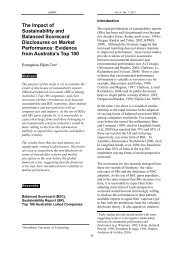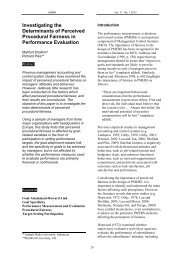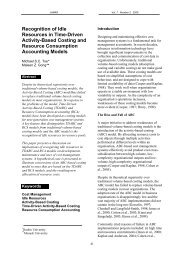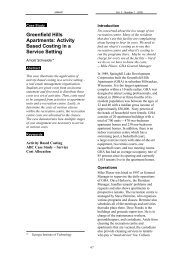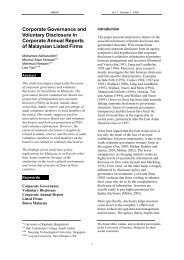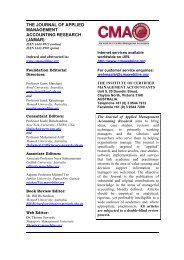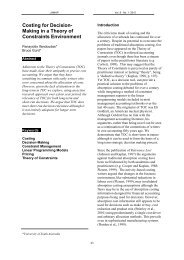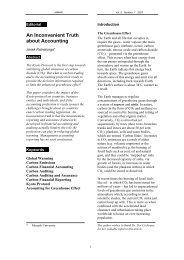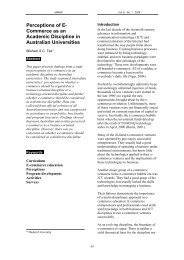Balanced Scorecard Design and Performance Impacts: Some ...
Balanced Scorecard Design and Performance Impacts: Some ...
Balanced Scorecard Design and Performance Impacts: Some ...
Create successful ePaper yourself
Turn your PDF publications into a flip-book with our unique Google optimized e-Paper software.
JAMAR Vol. 6 · Number 2 · 2008Table One : Industry (GICS) <strong>and</strong> SizeNon-BSC UsersBSC Users# % # %Energy 4 1.3 2 2.4Materials 27 9.1 7 8.2Industrials 99 33.3 23 27.1Consumer discretionary 64 21.5 12 14.1Consumer staples 32 10.8 10 11.8Health care 17 5.7 5 5.9Financials 35 11.8 15 17.6Information technology 8 2.7 7 8.2Telecommunications 8 2.7 1 1.2Utilities 3 1.0 3 3.5Total Firms 297 85Size (average employees)Company 6,797 17,296SBU 564 627Note: 33 non-BSC users <strong>and</strong> 7 BSC users did not fill in GICS codesVariable Measurement <strong>and</strong> DescriptiveDataRespondents were asked about threecharacteristics of their BSC design (the useof cause <strong>and</strong> effect logic in the developmentof the BSC, the linking of compensation tonon-financial measures <strong>and</strong> the extent thatthe BSC has been implemented throughoutthe organisational hierarchy), as well aseleven benefits <strong>and</strong> three outcomeindicators measuring various aspects of thesuccess of the BSC. Prior to sending out thesurvey, the items were pilot tested with twosenior accounting managers at a division ofa large international consumer goodscompany, with students in an accountingMBA class <strong>and</strong> academic staff. Piloting ofthe survey instrument resulted in a numberof minor changes, mainly to the wording ofquestions in the survey. As most of the datais either categorical or single itemmeasures, pilot testing focused on theconvergent underst<strong>and</strong>ing of the surveyitems. It is this convergence between pilottest subjects, particularly in cases wherelittle theory exists to guide development,that essentially determines the validity ofthe items or constructs used (Rossiter,2002; see also Bergkvist <strong>and</strong> Rossiter,2007). Furthermore, as the two multipleitem measures in this study (link tocompensation <strong>and</strong> extent ofimplementation) are indices or ‘formative’constructs (as opposed to reflective – seeBisbe, Batista-Foguet <strong>and</strong> Chenhall, 2007),the use of traditional validation techniques,such as confirmatory factor analysis <strong>and</strong>Cronbach’s Alpha, are inappropriate(Rossiter, 2002). Descriptive data is shownfor each of the three aspects of BSC designin Tables Two, Three <strong>and</strong> Four, <strong>and</strong> forbenefits <strong>and</strong> outcomes in Table Five.As shown in Table Two, a large number oforganisations do not use cause <strong>and</strong> effectlogic (43.5%), despite this being considereda central tenet of BSC design in practitionerliterature. <strong>Some</strong> organisations alsoindicated that they only used cause <strong>and</strong>effect logic between perspectives. Given thesimplicity of this type of logic, it is likely tohave few beneficial outcomes unlessmeasures within <strong>and</strong> between perspectivesare also linked together. These seven firmswere not considered as having used cause<strong>and</strong> effect logic in testing the firstproposition.24



